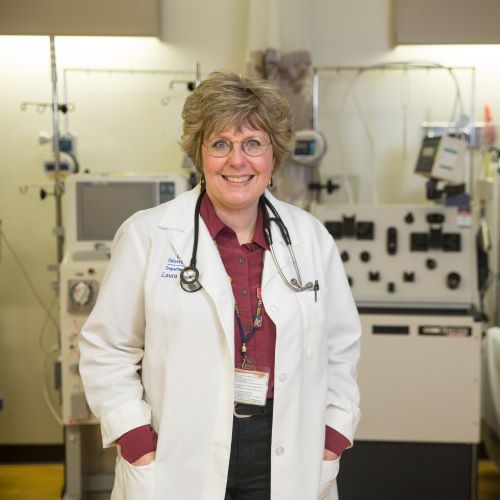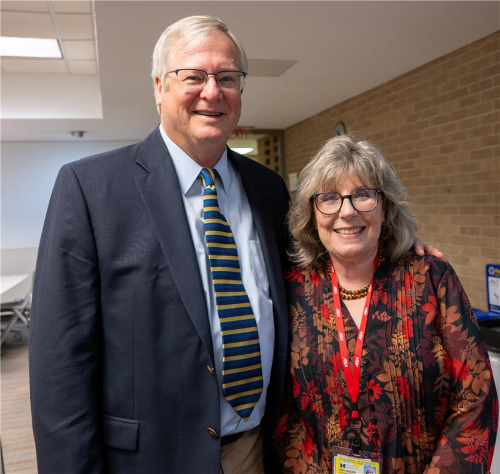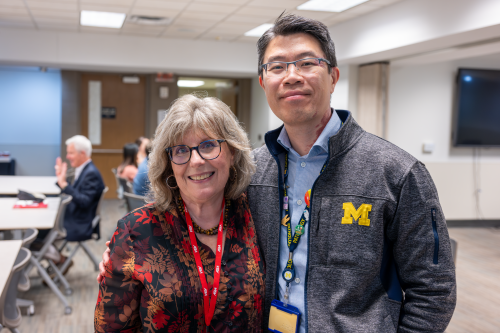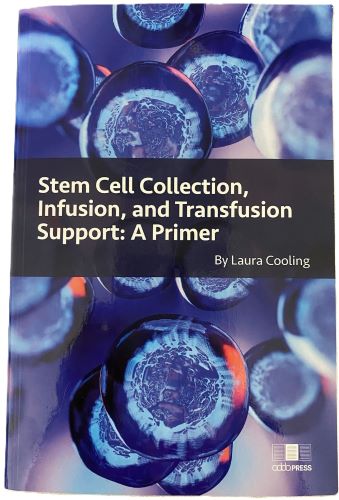

 Dr. Laura Cooling's family were not “academics” or professional class and, in fact, neither of her parents attended college. "But I have always loved science, and my dad was very supportive of me attending college and pursuing a career in medicine." Her mother was less enthusiastic until medical school graduation – thanks to a random stranger on a plane. "This stranger, whose own daughter was either recently divorced or widowed, emphasized that no matter what happened in life, I would always be able to support myself. My mom walked off that plane convinced that I had made the right choice.”
Dr. Laura Cooling's family were not “academics” or professional class and, in fact, neither of her parents attended college. "But I have always loved science, and my dad was very supportive of me attending college and pursuing a career in medicine." Her mother was less enthusiastic until medical school graduation – thanks to a random stranger on a plane. "This stranger, whose own daughter was either recently divorced or widowed, emphasized that no matter what happened in life, I would always be able to support myself. My mom walked off that plane convinced that I had made the right choice.”
Dr. Cooling attended the University of Iowa for her education. As an undergraduate at the University of Iowa, she studied microbiology, followed by a master’s degree in Pathology. “I actually put on my medical school application words to the effect of, ‘Please let me into medical school, because I want to run a microbiology laboratory,’” laughed Cooling. In her senior year of medical school at the University of Iowa, she completed an honors research project looking at sepsis-associated thrombocytopenia, particularly with urinary tract infections (UTI). “E. coli strains often implicated in UTI and urosepsis recognize blood group antigens for cell attachment. By the end of the project, I was more interested in the blood group antigens than the bacteria. That is how I ended up in blood banking. It has been a good fit.” After medical school, Cooling completed her pathology residency and a research fellowship at the University of Iowa. During her research fellowship, she worked with Dr. Ted Koerner, who was Cooling’s primary mentor. “It is because of Dr. Koerner that I was attracted to blood banking.” Under his guidance, Cooling completed her master’s thesis, Glycolipids of Human Platelets. Dr. Ron Strauss, the blood bank director at the University of Iowa, was another who strongly influenced Cooling. “He taught me a lot of medicine and hematology. Dr. Strauss was a pediatric hem/onc physician before going into blood banking later in life.”
 After her training was complete, Cooling took a position at SUNY in upstate New York. Three years later, “I saw the position announcement for the University of Michigan and sent my application by Fed Ex. The next week, I had an invitation to interview, and within weeks, I had a second visit and a contract. I will always be thankful to Jeff Warren for hiring me. Michigan has been a great place to work.”
After her training was complete, Cooling took a position at SUNY in upstate New York. Three years later, “I saw the position announcement for the University of Michigan and sent my application by Fed Ex. The next week, I had an invitation to interview, and within weeks, I had a second visit and a contract. I will always be thankful to Jeff Warren for hiring me. Michigan has been a great place to work.”
Over the years, Cooling has guided many medical school students who are considering Pathology but struggle with leaving clinical care. “It really is the best of all worlds. I explain to them that in Blood Banking, we have lab management, puzzle-solving, and troubleshooting difficult clinical cases, and we work directly with patients. In blood banking, you experience the adrenaline rush of emergency medicine when complications arise in the OR, during trauma cases, or in ICUs, and you must act quickly. You also have family medicine and long-term patient relationships in apheresis, with many patients seen once or twice a month for years. We get to know them, their spouse, and kids. I would often get Christmas cards, and once or twice, I received poinsettias from former patients. I knew some patients for 15 years before they eventually passed away. Because we know our patients so well, we are often able to pick up other health issues that need attention.”
 Cooling is excited about the future of the blood banking unit at Michigan. “The old crew are ‘of an age’ and likely retiring in the next few years. We are going to look like the JV squad compared to the next generation of Michigan blood bankers: Drs. Jensyn Cone Sullivan, Jennifer Jones, Shih Hon (Sean) Li, and Kai Rogers (coming October 2025). It is going to be an amazing division, led by one of our former fellows, Dr. Sean Li. Cooling credits Dr. Riccardo Valdez, our prior director of clinical pathology, with simultaneously hiring both Cone Sulliven and Jones. “Dr. Cone Sullivan has taken over cell therapy from me, and that section will be growing by leaps and bounds. Dr. Jones, a board-certified hematologist, has expertise in hemoglobin disorders, which is a growing segment of the apheresis service. Dr. Rogers, who will join us this fall, brings a wealth of experience and research in extracorporeal photopheresis (ECP), which was added to the apheresis service this summer. It gives me great peace of mind to know the division is in such good hands.”
Cooling is excited about the future of the blood banking unit at Michigan. “The old crew are ‘of an age’ and likely retiring in the next few years. We are going to look like the JV squad compared to the next generation of Michigan blood bankers: Drs. Jensyn Cone Sullivan, Jennifer Jones, Shih Hon (Sean) Li, and Kai Rogers (coming October 2025). It is going to be an amazing division, led by one of our former fellows, Dr. Sean Li. Cooling credits Dr. Riccardo Valdez, our prior director of clinical pathology, with simultaneously hiring both Cone Sulliven and Jones. “Dr. Cone Sullivan has taken over cell therapy from me, and that section will be growing by leaps and bounds. Dr. Jones, a board-certified hematologist, has expertise in hemoglobin disorders, which is a growing segment of the apheresis service. Dr. Rogers, who will join us this fall, brings a wealth of experience and research in extracorporeal photopheresis (ECP), which was added to the apheresis service this summer. It gives me great peace of mind to know the division is in such good hands.”
Ten years ago, Cooling was diagnosed with breast cancer. While she remains cancer-free today, she is among the small percentage of women with subsequent heart failure following treatment, which is a leading cause for her retirement. “I’ve learned a lot about cardiology in the last six years. Overall, breast cancer and CHF has made me a better doctor.” She went on to describe how chronic illnesses impact a patient’s entire life, including their loved ones.
Looking back over her career, Cooling fondly remembers working with two leaders in the field, John Judd and Suzanne Butch. “These are the luminaries in the history of transfusion medicine in the textbooks. Because I was at Michigan, I was able to work with them.” She laughingly relayed stories about working with Judd. “He helped me a great deal in my early career, but he was a crazy human being. I mean, who else arranges a funeral wake for Dolly, the cloned sheep, at the local pub?” She also has enjoyed working for Dr. Rob Davenport. “I can’t say enough about him. He is just the world’s best boss to work for. One of the great challenges in my life, however, is to get an actual laugh out of him. I can get an evil smile from him now and then, but the worst part is, he has the wickedest sense of humor. When he retires, believe me, I have material!”
Cooling rose through the ranks at the University of Michigan, serving as the Associate Medical Director of Blood Bank and Transfusion Medicine and Director of the Cell Therapy Laboratory, both positions which she filled for the past 25 years. She was promoted to Clinical Associate Professor in 2007, became the Director of the Immunohematology Reference Laboratory in 2016, and was promoted to Clinical Professor in 2017. She also rose to leadership positions in regional and national blood banking associations. She long served on the American Association of Blood Banking’s (AABB) Annual Meeting planning committee, eventually serving as chair for three national meetings.
 When asked about her key achievements, Cooling stated research in the glycoimmunology of platelets and biochemical characterization of the LKE blood group antigen. But her crowning achievement was an 80-page review on Blood Groups and Host Susceptibility published in Clinical Microbiology Reviews. “When they asked me to write this review, they told me I had no page limits and no reference limits - just make it complete. I had to explain blood groups to microbiologists and microbiology to blood bankers. I had over 750 references, and it took me a year to complete.” This publication, from 2015, has garnered over 160,000 views and has been cited more than a thousand times, particularly following the COVID pandemic. More recently, she wrote six chapters for a new textbook targeted toward resident and fellow trainees: “Key Concepts in Transfusion Medicine” (AABB Press). Unfortunately, one chapter was misplaced and subsequently reassigned to another author. When discovered, AABB published the chapter as a stand-alone book. “I wanted the book to be called Cellular Therapy for Beginners, but they wanted something more detailed. We finally agreed to “Stem Cell Collection, Infusion, and Transfusion Support: A Primer.” This required significant work within a very short timeframe, as the original chapter only required suggested readings and an index, with no specific citations. “Adding an index was a real learning experience for me, and not a fun one. A professional indexer without medical knowledge had prepared a terrible 16-page, unusable document. I had 48 hours to prepare a corrected index before it went to the printer.”
When asked about her key achievements, Cooling stated research in the glycoimmunology of platelets and biochemical characterization of the LKE blood group antigen. But her crowning achievement was an 80-page review on Blood Groups and Host Susceptibility published in Clinical Microbiology Reviews. “When they asked me to write this review, they told me I had no page limits and no reference limits - just make it complete. I had to explain blood groups to microbiologists and microbiology to blood bankers. I had over 750 references, and it took me a year to complete.” This publication, from 2015, has garnered over 160,000 views and has been cited more than a thousand times, particularly following the COVID pandemic. More recently, she wrote six chapters for a new textbook targeted toward resident and fellow trainees: “Key Concepts in Transfusion Medicine” (AABB Press). Unfortunately, one chapter was misplaced and subsequently reassigned to another author. When discovered, AABB published the chapter as a stand-alone book. “I wanted the book to be called Cellular Therapy for Beginners, but they wanted something more detailed. We finally agreed to “Stem Cell Collection, Infusion, and Transfusion Support: A Primer.” This required significant work within a very short timeframe, as the original chapter only required suggested readings and an index, with no specific citations. “Adding an index was a real learning experience for me, and not a fun one. A professional indexer without medical knowledge had prepared a terrible 16-page, unusable document. I had 48 hours to prepare a corrected index before it went to the printer.”
One of the aspects of blood banking that has kept Cooling engaged throughout her career is the puzzle-solving piece of the work. “I remember a patient who had hemolysis for years and did not respond well to therapy, and had an unclear, soft diagnosis. I looked at it and she reminded me of a case that I saw when I was a fellow at the University of Iowa. I suggested two additional tests in the reference lab, and sure enough, that was it. The staff who worked the bench said, ‘How did you know?’ It was simply because I had been practicing long enough and recognized the pattern. It also involved glycosylation, and that was the area I trained in for my research.”
 In retirement, Cooling is looking forward to gardening and spending time with her husband, Randy. “We will have been together for 49 years in November: I married my high school sweetheart. Randy worked to put me through medical school. He said, ‘There are many ways to invest your money. You are definitely a good return on my investment.’” She will also spend time teaching, writing manuscripts, and caring for her pet rabbit Mitzi. “She is an English Spot we adopted during COVID. She was found in
In retirement, Cooling is looking forward to gardening and spending time with her husband, Randy. “We will have been together for 49 years in November: I married my high school sweetheart. Randy worked to put me through medical school. He said, ‘There are many ways to invest your money. You are definitely a good return on my investment.’” She will also spend time teaching, writing manuscripts, and caring for her pet rabbit Mitzi. “She is an English Spot we adopted during COVID. She was found in  an abandoned building by a demolition crew. She had a heat stroke. She is a little tippy and can’t jump but has a very strong personality.” House rabbits are quite popular in the blood bank. “At one time, there were 8 or 9 rabbits owned by people in the blood bank – I think we are down to five now, but several folks in bone marrow transplant also own rabbits.”
an abandoned building by a demolition crew. She had a heat stroke. She is a little tippy and can’t jump but has a very strong personality.” House rabbits are quite popular in the blood bank. “At one time, there were 8 or 9 rabbits owned by people in the blood bank – I think we are down to five now, but several folks in bone marrow transplant also own rabbits.”
Thank you for sharing your life with us, Dr. Cooling! We wish you a long and happy retirement.